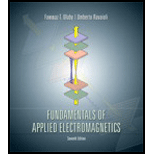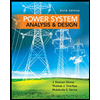
Fundamentals of Applied Electromagnetics (7th Edition)
7th Edition
ISBN: 9780133356816
Author: Fawwaz T. Ulaby, Umberto Ravaioli
Publisher: PEARSON
expand_more
expand_more
format_list_bulleted
Concept explainers
Question
Chapter 2.11, Problem 25CQ
To determine
The two degrees of freedom in case of the single stub matching network.
Expert Solution & Answer
Want to see the full answer?
Check out a sample textbook solution
Students have asked these similar questions
Don't use ai to answer I will report you answer
8-1) similar to Lathi & Ding, Prob. P.5.1-2
The figure below shows the Fourier spectra of signals of g,(t) and g₁(t). Determine the Nyquist rate and
the corresponding sampling interval for signals of g,(t), g,(t), g₁(1) - g¸(1), g¸³(t), and g₁(1)g₁(1).
Hint: Use the frequency convolution and the width property of convolution.
G₁(f)
G₂(f)
-8000
0 8000 f
-20000
10
20000 f
• We will use the Wattmeter to find the average power supplied/absorbed by each component.
The following figure shows how to connect the Wattmeter to measure the average power
absorbed by the resistor. Note that the Wattmeter consists of a Voltmeter and an Ammeter. The
Voltmeter must be connected in parallel with the component and the Ammeter must be connected
in series with the component. You must pay attention to the polarity of the voltage across the
component as well as the direction of the current flowing through the component.
5Vpk
1kHz
30°
ww
40
Z=A-JB
Wattmeter-XWM1
2.503 W
Power factor:
1.00000
Voltage
Current
•
•
Similarly connect a second Wattmeter to measure the average power supplied by the source.
Connect a third Wattmeter to measure the average power in the capacitor. Does this value agree
with the theoretical value?
Perform Interactive Simulation under Analysis and Simulation. Double click on Wattmeters to
see the average power values. Note that the Wattmeter also…
Chapter 2 Solutions
Fundamentals of Applied Electromagnetics (7th Edition)
Ch. 2.2 - What is a transmission line? When should...Ch. 2.2 - Prob. 2CQCh. 2.2 - What constitutes a TEM transmission line?Ch. 2.2 - Prob. 4CQCh. 2.2 - Prob. 1ECh. 2.2 - Calculate the transmission line parameters at 1...Ch. 2.4 - Verify that Eq. (2.26a) indeed provides a solution...Ch. 2.4 - A two-wire air line has the following line...Ch. 2.6 - The attenuation constant represents ohmic losses....Ch. 2.6 - How is the wavelength of the wave traveling on...
Ch. 2.6 - Prob. 7CQCh. 2.6 - What is a standing-wave pattern? Why is its period...Ch. 2.6 - Prob. 9CQCh. 2.6 - For a lossless transmission line, = 20.7 cm at 1...Ch. 2.6 - A lossless transmission line uses a dielectric...Ch. 2.6 - Prob. 7ECh. 2.6 - Prob. 8ECh. 2.6 - Prob. 10ECh. 2.6 - A 140 lossless line is terminated in a load...Ch. 2.8 - What is the difference between the characteristic...Ch. 2.8 - What is a quarter-wave transformer? How can it be...Ch. 2.8 - Prob. 12CQCh. 2.8 - Prob. 13CQCh. 2.8 - if the input impedance of a lossless line is...Ch. 2.8 - Prob. 12ECh. 2.8 - A 300 feedline is to be connected to a 3 m long,...Ch. 2.9 - According to Eq. (2.102b), the instantaneous value...Ch. 2.9 - Prob. 16CQCh. 2.9 - What fraction of the incident power is delivered...Ch. 2.9 - Prob. 18CQCh. 2.9 - For a 50 lossless transmission line terminated in...Ch. 2.9 - For the line of Exercise 2-14, what is the...Ch. 2.10 - The outer perimeter of the Smith chart represents...Ch. 2.10 - What is an SWR circle? What quantities are...Ch. 2.10 - What line length corresponds to one complete...Ch. 2.10 - Which points on the SWR circle correspond to...Ch. 2.10 - Prob. 23CQCh. 2.10 - Use the Smith chart to find the values of ...Ch. 2.11 - Prob. 24CQCh. 2.11 - Prob. 25CQCh. 2.12 - What is transient analysis used for?Ch. 2.12 - Prob. 28CQCh. 2.12 - What is the difference between the bounce diagram...Ch. 2 - A transmission line of length l connects a load to...Ch. 2 - Show that the transmission-line model shown in...Ch. 2 - A 1 GHz parallel-plate transmission line consists...Ch. 2 - For the parallel-plate transmission line of...Ch. 2 - In addition to not dissipating power, a lossless...Ch. 2 - For a distortionless line [see Problem 2.13] with...Ch. 2 - Prob. 15PCh. 2 - A transmission line operating at 125 MHz has Z0 =...Ch. 2 - Prob. 17PCh. 2 - Polyethylene with r=2.25 is used as the insulating...Ch. 2 - Prob. 20PCh. 2 - Prob. 21PCh. 2 - Prob. 22PCh. 2 - Prob. 23PCh. 2 - A 50 lossless line terminated in a purely...Ch. 2 - Prob. 26PCh. 2 - Prob. 27PCh. 2 - Prob. 29PCh. 2 - Prob. 30PCh. 2 - Two half-wave dipole antennas, each with an...Ch. 2 - Prob. 34PCh. 2 - For the lossless transmission line circuit shown...Ch. 2 - A lossless transmission line is terminated in a...Ch. 2 - The input impedance of a 31 cm long lossless...Ch. 2 - FM broadcast station uses a 300 transmission line...Ch. 2 - A generator with Vg=300 V and Zg = 50 is...Ch. 2 - If the two-antenna configuration shown in Fig....Ch. 2 - For the circuit shown in Fig. P2.44, calculate the...Ch. 2 - The circuit shown in Fig. P2.45 consists of a 100 ...Ch. 2 - An antenna with a load impedance ZL=(75+j25) is...Ch. 2 - Prob. 47PCh. 2 - Use the Smith chart to determine the input...Ch. 2 - Prob. 52PCh. 2 - A lossless 50 transmission line is terminated in...Ch. 2 - A lossless 50 transmission line is terminated in...Ch. 2 - Use the Smith chart to find yL if zL = 1.5 j0.7.Ch. 2 - Prob. 59PCh. 2 - Prob. 62PCh. 2 - Determine Zin of the feed line shown in Fig....Ch. 2 - Prob. 73PCh. 2 - A 25 antenna is connected to a 75 lossless...Ch. 2 - Prob. 75PCh. 2 - Prob. 76PCh. 2 - Prob. 77PCh. 2 - In response to a step voltage, the voltage...Ch. 2 - Suppose the voltage waveform shown in Fig. P2.77...Ch. 2 - For the circuit of Problem 2.80, generate a bounce...Ch. 2 - In response to a step voltage, the voltage...
Knowledge Booster
Learn more about
Need a deep-dive on the concept behind this application? Look no further. Learn more about this topic, electrical-engineering and related others by exploring similar questions and additional content below.Similar questions
- • We will use the Wattmeter to find the average power supplied/absorbed by each component. The following figure shows how to connect the Wattmeter to measure the average power absorbed by the resistor. Note that the Wattmeter consists of a Voltmeter and an Ammeter. The Voltmeter must be connected in parallel with the component and the Ammeter must be connected in series with the component. You must pay attention to the polarity of the voltage across the component as well as the direction of the current flowing through the component. 5Vpk 1kHz 30° ww 40 Z=A-JB Wattmeter-XWM1 2.503 W Power factor: 1.00000 Voltage Current • • Similarly connect a second Wattmeter to measure the average power supplied by the source. Connect a third Wattmeter to measure the average power in the capacitor. Does this value agree with the theoretical value? Perform Interactive Simulation under Analysis and Simulation. Double click on Wattmeters to see the average power values. Note that the Wattmeter also…arrow_forward8-3) Bandpass sampling A bandpass signal is confined to the frequency range from 7.5 to 10.5 kHz. Find the allowed ranges of the sampling rate for this signal. Sketch the amplitude spectrum of a hypothetical message, the amplitude spectrum of the sampled signal, and the transfer function of a suitable recovery filter if the sampling rate is chosen in the center of the lowest range available.arrow_forward8-4) Similar to Lathi & Ding, Prob. P.5.1-5 6.1-4 A low-pass signal g(t) sampled at rate of fs > 2B needs reconstruction. The sampling interval is Ts = 1/fs. (a) If the reconstruction pulse used is p(1) = [1 - specify the equalizer filter E(f) to recover g (1). (b) If the reconstruction pulse used is p(t) = П Ts/2 specify the equalizer filter E(f) to recover g (1).arrow_forward
- 8-2) Lathi & Ding, Prob. P.5.1-1 Determine the Nyquist sampling rate for the following signals, explaining your method: (a) 4 sinc(420лt); (b) 5sinc² (6500лt); (c) sinc(1800лt)+ sinc² (2000лt); (d) 2 sinc(500лt) sin(300л)arrow_forward2) A load consisting of a 1350 Q2 resistor in parallel with a 405 mH inductor is connected across the terminals of a sinusoidal voltage source Vg, where Vg = 90 cos(2500t) V. Find a) the average power delivered to the load, b) the reactive power for the load, c) the apparent power for the load, and d) the power factor of the load.arrow_forward4) Find the phasor voltage Vs for the following circuit if loads L1 and L2 are absorbing 15 kVA at 0.6 pf lagging and 6 kVA at 0.8 pf leading, respectively. Express Vs in polar form. + j10 + 200/0° V(rms) | L1 Li L2arrow_forward
- 3) A 100-V rms, 60 Hz source is applied to a load impedance Z. The apparent power entering the load is 120 VA at a power factor of 0.707 lagging. a) Calculate the complex power b) Find the rms current supplied to the load c) Determine Z d) Assuming that Z = R + jwL, find the values of R and L.arrow_forward1) Find the average power delivered by the ideal current source in the following circuit if ig = 30 cos(25000t) mA. 202 w 50 w 40 με 40 pHarrow_forwardAnswer question 3 using Multisim pleasearrow_forward
- Answer question 2 using Multisim pleasearrow_forwardQ1. Choose the correct answer 1. With fixed number of quantization levels in PCM, the quantization noise is (linearly proportional to signal amplitude, non-linearly proportional to signal amplitude, linearly proportional to signal frequency, non-linearly proportional to signal frequency). 2. A PCM encoder uses 130 quantization levels. Which of the following N bits is more economical to encode such signal? (N=6, N=7, N=9, N=10). 3. Frequency Shift Keying can be accomplished by _multiplying two On-Off Keying signals, combining two Frequency Shift Keying signals, adding two (adding two On-Off Keying signals, Frequency Shift Keying signals). 4. Which of the following statements is true with respect to PCM? (The parallel binary data is converted into serial before transmission, Analog data is transmitted directly, Analog signal is amplified before transmission, The analog signal is converted into parallel binary data before transmission). 5. A baseband speech signal of maximum frequency of…arrow_forwardThree speech signals are TDM multiplexed with a high-quality music signal. If each speech signal is sampled at 16 kHz and PCM quantized by 8 bits/sample, while the music signal is sampled at 64 kHz with the same PCM quantizer. 1. Draw the block diagram of this TDM. 2. Calculate the output bit rate of this TDM.arrow_forward
arrow_back_ios
SEE MORE QUESTIONS
arrow_forward_ios
Recommended textbooks for you
 Power System Analysis and Design (MindTap Course ...Electrical EngineeringISBN:9781305632134Author:J. Duncan Glover, Thomas Overbye, Mulukutla S. SarmaPublisher:Cengage Learning
Power System Analysis and Design (MindTap Course ...Electrical EngineeringISBN:9781305632134Author:J. Duncan Glover, Thomas Overbye, Mulukutla S. SarmaPublisher:Cengage Learning EBK ELECTRICAL WIRING RESIDENTIALElectrical EngineeringISBN:9781337516549Author:SimmonsPublisher:CENGAGE LEARNING - CONSIGNMENT
EBK ELECTRICAL WIRING RESIDENTIALElectrical EngineeringISBN:9781337516549Author:SimmonsPublisher:CENGAGE LEARNING - CONSIGNMENT Electricity for Refrigeration, Heating, and Air C...Mechanical EngineeringISBN:9781337399128Author:Russell E. SmithPublisher:Cengage Learning
Electricity for Refrigeration, Heating, and Air C...Mechanical EngineeringISBN:9781337399128Author:Russell E. SmithPublisher:Cengage Learning

Power System Analysis and Design (MindTap Course ...
Electrical Engineering
ISBN:9781305632134
Author:J. Duncan Glover, Thomas Overbye, Mulukutla S. Sarma
Publisher:Cengage Learning

EBK ELECTRICAL WIRING RESIDENTIAL
Electrical Engineering
ISBN:9781337516549
Author:Simmons
Publisher:CENGAGE LEARNING - CONSIGNMENT

Electricity for Refrigeration, Heating, and Air C...
Mechanical Engineering
ISBN:9781337399128
Author:Russell E. Smith
Publisher:Cengage Learning
How do Electric Transmission Lines Work?; Author: Practical Engineering;https://www.youtube.com/watch?v=qjY31x0m3d8;License: Standard Youtube License